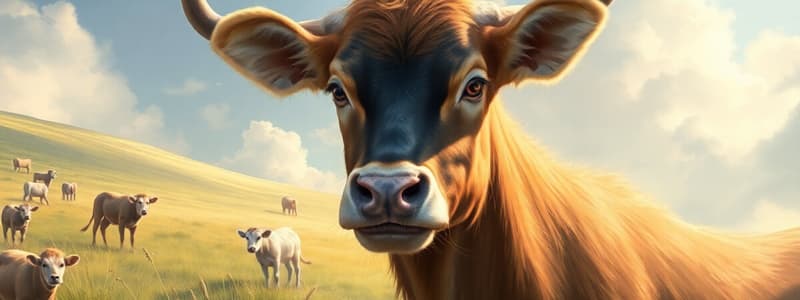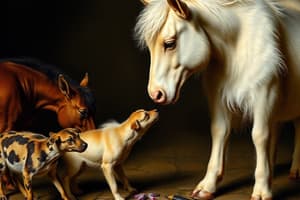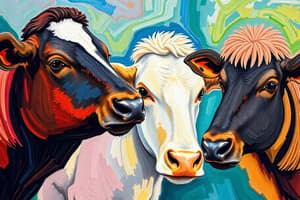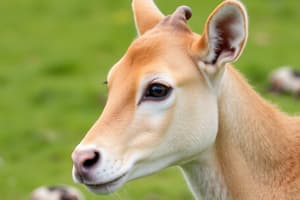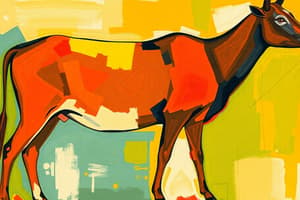Podcast
Questions and Answers
Which of the following is the MOST accurate definition of domestication?
Which of the following is the MOST accurate definition of domestication?
- Changing a population of organisms at the genetic level through selective breeding. (correct)
- Altering an animal's behavior to coexist with humans in a shared environment.
- Creating a mutually beneficial relationship between humans and animals.
- Training an animal to perform specific tasks.
Which characteristic is LEAST likely to be observed as a result of domestication?
Which characteristic is LEAST likely to be observed as a result of domestication?
- Increased tameness.
- Development of floppy ears.
- Uniform coat color. (correct)
- Decreased skull size.
What was the PRIMARY selection criterion used in Belyaev's fox experiment?
What was the PRIMARY selection criterion used in Belyaev's fox experiment?
- Coat color.
- Physical size.
- Hunting ability.
- Temperament. (correct)
Which of the following BEST describes the effect of domestication on adrenal glands?
Which of the following BEST describes the effect of domestication on adrenal glands?
According to the neural crest hypothesis, what is the relationship between domestication and neural crest cell size?
According to the neural crest hypothesis, what is the relationship between domestication and neural crest cell size?
Which of the following BEST describes the commensal pathway of domestication?
Which of the following BEST describes the commensal pathway of domestication?
Which of the following is a key difference between extensive and intensive animal production systems?
Which of the following is a key difference between extensive and intensive animal production systems?
In the context of beef cattle production, what does "backgrounding" or "stocker" refer to?
In the context of beef cattle production, what does "backgrounding" or "stocker" refer to?
What is the main purpose of 'supply management' in the Canadian dairy industry?
What is the main purpose of 'supply management' in the Canadian dairy industry?
Why is colostrum so important for newborn calves?
Why is colostrum so important for newborn calves?
Which of the following BEST describes the primary goal of colostrum management in dairy cattle?
Which of the following BEST describes the primary goal of colostrum management in dairy cattle?
Which factor is LEAST likely to impact the genetic potential of dairy cows?
Which factor is LEAST likely to impact the genetic potential of dairy cows?
What is the typical gestation period for swine?
What is the typical gestation period for swine?
What does the term "gilt" refer to in swine production?
What does the term "gilt" refer to in swine production?
Which statement accurately reflects modern swine production in Canada?
Which statement accurately reflects modern swine production in Canada?
What percentage of all pig production occurs in Saskatchewan?
What percentage of all pig production occurs in Saskatchewan?
Which of the following is NOT an advantage of supply management in the Canadian poultry industry?
Which of the following is NOT an advantage of supply management in the Canadian poultry industry?
What is the MOST common reason why chicken is the most consumed meat in the world?
What is the MOST common reason why chicken is the most consumed meat in the world?
What does the term "layer" refer to in poultry terminology?
What does the term "layer" refer to in poultry terminology?
What is a characteristic of family farms in Canada's supply management system?
What is a characteristic of family farms in Canada's supply management system?
Which of the following statements BEST describes the role of forages in cow-calf operations?
Which of the following statements BEST describes the role of forages in cow-calf operations?
What is the MAIN purpose of Canada's Traceability Program for beef?
What is the MAIN purpose of Canada's Traceability Program for beef?
Which factor is LEAST relevant to Canada's Traceability Program?
Which factor is LEAST relevant to Canada's Traceability Program?
Why are forages so important for cow-calf operations?
Why are forages so important for cow-calf operations?
What is the MOST likely reason why wolves with shorter flight distances were more successful around early human settlements?
What is the MOST likely reason why wolves with shorter flight distances were more successful around early human settlements?
What is the name for the act of parturition in pigs?
What is the name for the act of parturition in pigs?
Which of the following is NOT an example of sector production system?
Which of the following is NOT an example of sector production system?
Which of the following is the most accurate description of quota limits in the Canadian dairy industry?
Which of the following is the most accurate description of quota limits in the Canadian dairy industry?
What is the typical duration of lactation cycle in dairy production?
What is the typical duration of lactation cycle in dairy production?
What is the primary reason why a cow might experience milk fever?
What is the primary reason why a cow might experience milk fever?
How did domestication impact the way that cats look and behave?
How did domestication impact the way that cats look and behave?
How did domestication impact the diets of dogs?
How did domestication impact the diets of dogs?
What is the relationship between dog and cat ownership?
What is the relationship between dog and cat ownership?
Which of the following is NOT a benefit to pet ownership?
Which of the following is NOT a benefit to pet ownership?
What is the major distinction between Animal Assisted Therapy and Animal Assisted Activities?
What is the major distinction between Animal Assisted Therapy and Animal Assisted Activities?
Which evolution of the horse came first?
Which evolution of the horse came first?
What was the first purpose horses were used for after domestication?
What was the first purpose horses were used for after domestication?
Gray horses are more likely to have what issue?
Gray horses are more likely to have what issue?
Leopard Spotting horses are more likely to have what issue?
Leopard Spotting horses are more likely to have what issue?
Which of the following swine breeds makes up 42% of the herd in Canada?
Which of the following swine breeds makes up 42% of the herd in Canada?
Which of the following is the latin name for domestic swine?
Which of the following is the latin name for domestic swine?
Flashcards
What is domestication?
What is domestication?
Changing a population of living organisms at the genetic level through selective breeding for desirable traits to benefit humans.
Examples of Domestic animals
Examples of Domestic animals
Pets, cats, dogs, horses, and cows.
Degrees of Domestication?
Degrees of Domestication?
Wild (fight or flight), tamed, semi-domesticated, and domesticated.
Common traits from domestication?
Common traits from domestication?
Signup and view all the flashcards
Belyaev's Fox Experiment
Belyaev's Fox Experiment
Signup and view all the flashcards
What is Tameness?
What is Tameness?
Signup and view all the flashcards
Hormones and Tameness
Hormones and Tameness
Signup and view all the flashcards
Neural Crest Hypothesis
Neural Crest Hypothesis
Signup and view all the flashcards
Wolf Domestication
Wolf Domestication
Signup and view all the flashcards
Commensal Domestication
Commensal Domestication
Signup and view all the flashcards
Prey Domestication Pathway
Prey Domestication Pathway
Signup and view all the flashcards
Extensive Animal Systems
Extensive Animal Systems
Signup and view all the flashcards
Intensive Animal Systems
Intensive Animal Systems
Signup and view all the flashcards
Sector stages for cattle production
Sector stages for cattle production
Signup and view all the flashcards
Cattle lifecycle terms?
Cattle lifecycle terms?
Signup and view all the flashcards
Pork terms?
Pork terms?
Signup and view all the flashcards
Modern Swine Production
Modern Swine Production
Signup and view all the flashcards
Swine reprodution
Swine reprodution
Signup and view all the flashcards
swine grow out?
swine grow out?
Signup and view all the flashcards
Swine: finishing
Swine: finishing
Signup and view all the flashcards
Dairy Production
Dairy Production
Signup and view all the flashcards
Parturition, Milk Fever
Parturition, Milk Fever
Signup and view all the flashcards
milk production
milk production
Signup and view all the flashcards
Who determines quota limits?
Who determines quota limits?
Signup and view all the flashcards
Minimum prices in milk market
Minimum prices in milk market
Signup and view all the flashcards
High tariffs?
High tariffs?
Signup and view all the flashcards
Why colostrum matters
Why colostrum matters
Signup and view all the flashcards
Passive immunity is colostrum
Passive immunity is colostrum
Signup and view all the flashcards
Animal ID
Animal ID
Signup and view all the flashcards
Dominant Cattle Breeds?
Dominant Cattle Breeds?
Signup and view all the flashcards
Calf Sales option
Calf Sales option
Signup and view all the flashcards
Poultry terminology
Poultry terminology
Signup and view all the flashcards
Chicken meat consumption
Chicken meat consumption
Signup and view all the flashcards
Supply management ADVANTAGES
Supply management ADVANTAGES
Signup and view all the flashcards
Supply management DISADVANTAGES
Supply management DISADVANTAGES
Signup and view all the flashcards
Horse timeline
Horse timeline
Signup and view all the flashcards
Horse use
Horse use
Signup and view all the flashcards
horse colors
horse colors
Signup and view all the flashcards
Detrimental genetic factors
Detrimental genetic factors
Signup and view all the flashcards
domestic pig origin
domestic pig origin
Signup and view all the flashcards
Canadian Swine Breeds
Canadian Swine Breeds
Signup and view all the flashcards
Study Notes
- Domestication is a process that changes a population of living organisms at the genetic level
- Selective breeding accentuates traits that benefit humans
- Domestic animals include pets, cats, dogs, horses, and cows
Degrees of Domestication
- Wild animals exhibit a "fight or flight" response
- Tamed animals show some dependence on humans
- Semi-domesticated animals have a human-animal relationship
- Domesticated animals are reliant on humans
Common Changes in Traits Due to Domestication
- Adrenal glands relate to tameness
- Melanocytes affect coat color
- Chondrocytes result in a reduced skull
- Odontocytes lead to reduced teeth
- Morphological changes occur
- Floppy ears develop
Belyaev's Fox Experiment
- Foxes were selected based on temperament
- The study started with 465 foxes
- The objective was to simulate the process that turned wolves into present-day dogs
- 30% of the foxes were extremely reactive
- 40% were moderately reactive
- 20% were fearful
- 10% were quiet and exploratory
- Breeding criteria involved assessing flight threshold distance
Tameness and Hormones
- Tameness involves a reduction in the release of stress hormones
- Reduced fight-or-flight response is observed
- Decreased reactivity to new situations occurs
- Hormones are produced by adrenal glands, located on top of the kidney
- Glucocorticoids, like cortisol, are long-term hormones that regulate the duration of neonatal development
- Catecholamines, including epinephrine and norepinephrine, are short-term hormones
- Domestic animals have lower levels of these hormones compared to wild animals
Neural Crest Hypothesis
- Genetic changes to neural crest cells cause domestication traits
- Domestication involves a decrease in the size of the neural crest
- A reduced number of cells derived from the neural crest has been observed
- Tameness arises due to reduced stress hormone synthesis because cells that produce these hormones come from the neural crest
- A smaller number of cells involved leads to domestication syndrome
Wolf Domestication
- Wolves with a short flight distance could take advantage of food waste from humans, giving them a competitive advantage
- These wolves tended to breed with each other
- Domestication syndrome developed in these wolves
Domestication Pathways
- Commensal pathway: Habituation leads to partnership, and that leads to directed breeding
- Prey pathway: Prey turns into game management, which transitions to herd management, and then directed breeding
Extensive vs. Intensive Animal Systems
- Extensive systems minimize capital inputs and use unprocessed diets of low nutrient and high fiber density and involve minimal handling, seen in beef cattle, sheep, and goat
- Intensive systems involve significant capital inputs, processed and nutrient-dense diets, confinement production, and economies of scale, seen in pork, dairy, and poultry
Sector Types
- Cow-calf operations are primary in extensive production
- Pasture and rangeland are used
- Backgrounding/stocker operations use forage/pasture diets and result in slow growth
- Feedlot/finishing operations occur in intensive production
- Primarily concentrated diets are used in feedlots with some pasture and packing sectors
Animal Lifecycle Terms
- Cow: mature female
- Heifer: young female
- Bull: sexually mature uncastrated male
- Steer: castrated male before sexual maturity
- Calf: neonatal to 5 months of age
- Gestation period in cattle: 283 days, with 82 days to get pregnant post calving
Pork Terms
- Sow: mature female pig
- Gilt: immature female pig before 2nd pregnancy
- Boar: mature male pig
- Barrow: castrated male pig
- Piglet: neonatal pig before weaning
- Farrowing: giving birth to piglets
Modern Swine Production in Canada
- Intensive industry with pigs typically raised in total confinement throughout their lives
- Biosecurity is very important on commercial farms
- There are limited visitors
- Breeding is done through artificial insemination
- Gestation: 3 months, 3 weeks, 3 days
Farrowing
- Sows are kept in individual crates
- Average litter size is 15 piglets
- Average birth weight is 1.2 kg
- Colostrum intake is important in the first 6 hours
- Most sows have 12 teats
Weaning
- Abrupt weaning occurs with piglets moved to a nursery
- Piglets transition from milk to a solid feed
- Piglets are mixed with other piglets
- Weaning occurs at 21-28 days old
Grow-Finish
- After 5 weeks in the nursery, pigs are housed in large groups
- Diets are changed as pigs mature
- Pigs are ready for market in 15 weeks, weighing 125 to 130 kg
Dairy Production
- Lifecycle: lactation cycle to life span to calves
- Parturition and milk fever require cows to mobilize large amounts of calcium from the skeleton
- Insufficient calcium can cause muscle tremors, staggering, lying flat, heart failure, and death
Supply Management in Canada
- Supply management is designed to meet the demand of Canadians
- There are limited exports and imports of milk and milk products
- The quantity of milk required is established for each province
- Quota provides a license to produce up to a set amount of milk
- The national marketing agency determines production amounts and sets production quotas for each province
- Producers are guaranteed a minimum price for their products
- High tariffs make imported dairy products expensive
Importance of Colostrum
- Calves are born with no immunoglobulins in their bloodstream
- The small intestine of the newborn can absorb immunoglobulins into the blood for the first 24 hours after birth, known as passive immunity
- Antibodies are Y-shaped proteins that bind to bacteria and viruses
North American Beef Industry
- Sectored production system includes cow-calf, backgrounding, feedlot, and packer operations
- There are >90,000 producers in Canada
Canadian Beef Industry
- There are 15 million cattle and calves
- Majority family-run operations
Forages
- Forages - "Foundation of the Beef Industry;" includes pasture, hay, straw, and silage
- Forage is a major feed component of beef cattle
- Feed is the single greatest variable cost in beef production
- Focus is on energy, protein, minerals, vitamins, and water
Canada's Traceability Program
- Based on animal identification with radio frequency identification tags
- Individual ID and Premise ID are required, and cattle must have to leave property
- Premise identification and animal movement are tracked
Cattle Breed Varieties
- Dominant breeds include Angus, Simmental, Hereford, Charolais, and Limousin
- Cattle vary in color, carcass quality, behaviour, frame size, and feed efficiency
Weaned Calf Sales
- Calves are sold in groups through auction marts to feedlot buyers
- Internet/video sales are a sale option
- Forward contracts with feedlots occur where calves are delivered for a pre-arranged price, eliminating the 'sale barn'
Poultry Terminology
- Broiler: meat chicken
- Layer: table egg production chicken
- Rooster: male chicken
- Tom: male turkey
- Hen: female turkey or chicken
Chicken Consumption
- Canada's supply management system produces as much chicken as consumed
Poultry Supply Management
- Family farms are common which are located in Canada
- Producers receive a steady income
- Vaccines are available, but politicians restrict their use
-
1000 broilers = commercial
Advantages of Poultry Supply Management
- Producers get a steady income
- There is a steady supply without oversupply
- Producers can support additional welfare initiatives
- Boards influence practices for animal welfare
Disadvantages of Poultry Supply Management
- Products are more expensive for consumers
- Future producers must purchase quota
Horse Evolution and Domestication
- Equus evolved in North America
- Ancestral migration to Eurasia occurred
- Horses spread across the Eurasian steppes
- Horses were hunted for food and later raised in captivity for domestication
Horse History and Domestication
- Horses were first used for carrying and hauling
- Horses then became effective for war tactics
- Horses began using horses for riding
Coat Colours and Disadvantages in Horses
- Colours with selective disadvantages exist
- Some colours result in negative pleiotropic effects (gene that effects more than 1 system)
- Grey horses have melanomas
- Silver horses have MCOA- eye disorder
- Leopard Spotting horses have CSNB
- Overo Pinto horses have OLWFS
- Splashed white horses have deafness
- Overo horses have deafness
- White horses are embryonic lethal
- Roan horses are embryonic lethal
Detrimental Effects of Horse Specialization
- Breeding for small size can cause dwarfism
- Breeding heavily muscled quarter horses can cause periodic paralysis
- Breeding for speed can propagate fragility
- "Popular sire" can lead to a disequilibrium between detrimental genes and performance genes
Domestic Pig Information
- Domesticated in China (490 B.C) and England (800 B.C.)
- Latin name: Sus scrofa domesticus
Canadian Swine Breeds
- Yorkshire are 42% of the herd
- Landrace are 32%
- Duroc are 25%
- Others: Hampshire, Lacombe, Pietrain, Berkshire
Swine Production System Terms
- Swine = pig
- Pork = pig meat
- Sow = mother pig
- Gilt = of breeding age, but hasn’t had piglets
- Weaning = is the removal of young ones from their mother
- Hog = pig ready to be processed
- Process/harvest = slaughter for meat
- Boar = adult male pig kept for breeding purposes
- Farrowing = act of parturition in pigs
Pork Production in SK
- Saskatchewan accounts for 8.5% of all pig production and is the 5th largest producer of hogs
Swine Operation Changes
- Advances in technology and transportation
- Economies of scale
Dog and Cat Trends
- Cat ownership is greater than dog ownership
- 8.5 million cats are kept as pets in comparison of 7.9 million dogs
Pet cost
- Pet cat cost ≈ $2,542
- Pet dog cost ≈ $2,500 + $1,000
- Ontario = 770 pet stores in 2021 (brick and mortar stores are declining, as online purchases increase)
Domestication of Cats and Dogs
- Dogs started with hunter-gatherer societies, descended from unknown wolf, started as mutual co-existence then companionship.
- Changed the way dogs look and behave
- Increased ability to digest carbohydrate-rich diet through amylase enzyme increase.
- Cats =are more recent, cats aren't as dependent on or responsive to humans as dogs.
- Domestication HAS NOT changed the way cats look and behave
- Easily revert to feral
- Diet preference and metabolism have remained roughly unchanged from wild cats.
Benefits of Health through Pet owernship
-Social support -Companionship
- Improved health Motivates exercise
- Assisted therapy and activities
- Empathy/ social skills
Risks of Health through Pet Risk
- Infections
- Parasites
- Allergies
- Bites/ injuries
- Psychological events of death
- Neglect
Contrasting assisted therapy and animal assisted activities
- The first is part of treatment, and includes emotional and cognitive challenges. In which each session has goals, there is an administration, and schedules
- The second is involved in causal activities that may include a typically volunteer run
Supply Management
- Involves management to design the demands of Canadians, within imported products
- Quantity and control is made for each Province.
How are dairy cattle managed
- Bred every 365 days, calves are bread earlier between 13 to 15 months
- Breed/have first calf around months 22 to24
Other Major management
- Colostrum management or passive transferees can also manage the yields overtime using cows within an comfort environment.
Achieves for genetic potential
- Achieves by a healthy environment with calm handling
Key Aspects for management of Dairy Cattle
- Take if or lose it
Review of Indigenious Principles
Distinctions exist between 'First Nation', 'Metis', and 'Inuit', each of which involve a complex interplay of culture, history, practice of sustainable agriculture.
Indigenous principles for sustainable practice
Transparency with FN and other Nations Economic responsibility
Differences between Aboriginal/Non-Aboriginal
Includes the need for culture/spiritual aspects of unique connections within the land, and resources in concern
Studying That Suits You
Use AI to generate personalized quizzes and flashcards to suit your learning preferences.
